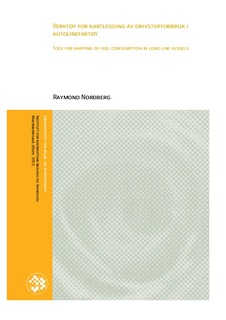| dc.description.abstract | Denne oppgaven handler om energieffektivisering av fiskefartøy. Innledningsvis gjøres leseren kjent
med fisk sin betydning som næringskilde, ulike metoder for fiske og energibruk forbundet med fiske.
Det blir formidlet at fiske forsyner verden med næring relativt energieffektivt, men at det finnes både
miljømessige og økonomiske grunner til å redusere forbruket av fossilt drivstoff. Det er også et poeng
at det ikke nødvendigvis er lurt å øke årlig fangst av fisk, da allerede mesteparten av verdens
fiskebestander har møtt sin grense for bærekraftig fangst.
For å oppmuntre til reduksjon av drivstofforbruk blir det utviklet et verktøy i Microsoft Excel som skal
hjelpe brukere av fiskefartøy å kartlegge og analysere drivstofforbruket i sitt fartøy. Av tidsmessige
hensyn er det i oppgaven fokusert på fiskefartøy av typen autoline.
Oppgaven er, når en ser bort fra innledning og konklusjon, delt i to deler. Første del behandler
utvikling og design av regneverktøyet. For å undersøke om verktøyets utdata gir anvendbar
informasjon benyttes regneverktøyet også til å analysere fartøyene i verktøyets datagrunnlag mot
slutten av oppgavens første del. En kommer da frem til at kalkulatoren gir interessant informasjon,
men trenger å videreutvikles for å sørge for at alle formler er korrekte og at inndata kalkulatoren
spør etter er mulig å besvare for mannskap på et autolinefartøy. Analysen av autolinefartøy i
datagrunnlaget kan indikere på at drift av et gjennomsnittlig autolinefartøy er lite energieffektiv med
hensyn til hvordan spesifikt drivstofforbruk varierer med belastning i en ordinær dieselmotor. Det
antydes derfor at installering av akselgenerator kan bidra til å redusere fartøyets gjennomsnittlige
drivstofforbruk ved at hovedmotoren kjøres nærmere belastningen for optimalt spesifikt
drivstofforbruk. Det foreslås også at økt bruk av hovedmotor kan gjøre det hensiktsmessig å
installere teknologi for generering av elektrisitet fra varme i motorens avgasser.
I oppgavens andre del diskuteres mulige reduksjoner av drivstofforbruk ved implementering av
teknologiene foreslått i oppgavens første del. En kommer da frem til at tekstens relativt grove, men
realistiske, estimater indikerer at et gjennomsnittlig autolinefartøy, basert på utvalget av autoline i
regneverktøyets datagrunnlag, kan spare mellom én til tre prosent av sitt totale drivstofforbruk ved
bruk av akselgenerator. Hvis det i tilegg installeres teknologi for å generere elektrisitet fra varmen i
hovedmotorens avgasser kan det være mulig å redusere drivstofforbruket ytterligere fire prosent. Abstract
The subject of this thesis is energy efficiency of fishing vessels. The reader is introduced to the fishing
industry, fish as a source of nutrition and the energy use of industrial fishing. It is pointed out that
although fishing is a relatively efficient way of harvesting animal proteins; the consumption of fossil
fuels in the industry should be reduced based on economical and environmental considerations. It is
also pointed out that the global fishing stocks mostly are fully exploited and that there are limited
possibilities to sustainably increase the harvest from fishing.
To encourage lower fuel consumption of fishing vessels it is in this text developed and designed a
calculator, based on Microsoft Excel, that will aid users of long line vessels to map and analyze the
fuel consumption of their vessel. The data of the vessel will also be compared with data from
similar long line vessels.
The paper is divided into two parts. The first part treats the development and designing of the
calculator. To examine whether the tool gives relevant information the calculator is also used to
This analysis indicates that the calculator provides interesting information, but needs further
development to make sure that the data resources demanded are information known to the users of
long line vessels as well as to make sure that the calculations are correct. The analysis also indicates
that the operation of the main engine on a typical long line vessel is not sufficiently energy efficient
considering how the specific fuel consumption of a typical marine diesel engine varies under
different loads. It is therefore suggested that the installation of a shaft generator could reduce the
average fuel consumption of a typical long line vessel by increasing the load on the main engine
closer to the load of optimal specific fuel consumption. It is also suggested that increased use of the
vessels main engine will make it suitable to install technology to generate electricity of the heat from
the engines exhaust gases.
In the second part of the text some possible reductions of fuel consumption in an average long line
vessel is discussed based on the technologies suggested in the first part of the text. It is then
y reduce its fuel
consumption 1 % to 3 % by using a shaft generator, based on the relatively rough estimates made in
the text. By also installing a system to generate electricity from the heat in the exhaust gases of the
main engine it could be possible to reduce the fuel consumption a further 4 %. | no_NO |
